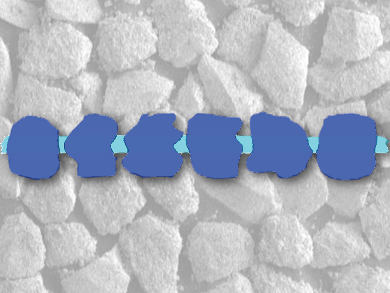Lithium-ion batteries (LIBs) usually contain a liquid electrolyte and lithium-intercalating electrode materials for anode and cathode. For a high energy density, the use of metallic lithium anodes is essential. Unfortunately, their application is hindered by the highly nonuniform electrochemical deposition of lithium during recharging. This leads to the formation and growth of needle-like crystals (dendrites), which ultimately cause a short circuit of the battery.
Previous efforts to prevent dendrite growth included the use of lithium-ion conduction ceramics (LICCs), which mechanically suppress dendritic growth. However, they have to be of substantial thickness, which prevents practical application.
Ho-Cheol Kim, IBM Research, San Jose, CA, USA, and colleagues describe a flexible lithium-ion conducting membrane, which consists of only a single layer of LICC particles (pictured dark blue) firmly embedded in a polymer matrix (light blue), with their top and bottom surfaces exposed to allow lithium-ion transport. The membrane shows high lithium-ion conductivity as well as high mechanical stability at a thickness of only 100 μm. The researchers showed that the membrane successfully prevents the growth of lithium dendrites, thus enabling the use of metallic lithium anodes in lithium-ion batteries.
- Flexible Ion-Conducting Composite Membranes for Lithium Batteries,
Nagaphani B. Aetukuri, Shintaro Kitajima, Edward Jung, Leslie E. Thompson, Kumar Virwani, Maria-Louisa Reich, Miriam Kunze, Meike Schneider, Wolfgang Schmidbauer, Winfried W. Wilcke, Donald S. Bethune, J. Campbell Scott, Robert D. Miller, Ho-Cheol Kim,
Adv. Energy Mater. 2015.
DOI: 10.1002/aenm.201500265




